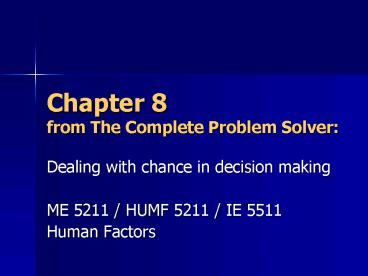Chapter 8 from The Complete Problem Solver: PowerPoint PPT Presentation
1 / 16
Title: Chapter 8 from The Complete Problem Solver:
1
Chapter 8 from The Complete Problem Solver
- Dealing with chance in decision making
- ME 5211 / HUMF 5211 / IE 5511
- Human Factors
2
Dealing with chance in decision making
- Risk there are several possible outcomes, but
the probability of those outcomes can be
calculated or estimates. (e.g. card games). - Uncertainty there are several possible outcomes
but it is not possible to calculate probabilities
for the outcomes. (career choice) - Unknown an event or outcome that was not even
anticipated or thought of. (what you might
encounter in space exploration) - Conflict many outcomes are possible, and an
enemy is trying to outwit you and foil your
strategy. (chess)
3
Decision MakingCertainty vs Uncertainty
- In making decisions under
- Certainty the task is to choose the alternative
that is best. Assume that you will get that
choice. - Uncertainty You might not get what you choose.
4
Decision Making Strategies
- Decision making strategies in Chapter 8
(Complete Problem Solver) provide a way of
addressing uncertainty it is uncertain how much
value one will actually derive from an
alternative under different conditions. - Some decision making strategies accommodate
different decision makers tolerance for risk (or
lack of tolerance).
5
Expected Value
- Expected Value (EV) average payoff from a
decision. - Example coin toss games
- Game 1 Win 2 automatically
- Game 2 Heads win 10 tails loose 5
- Which game should you play?
6
Expected Value
- Calculate the expected value of each
- EV p(heads)v(heads) (tails)v(tails)
- where p probaility, vvalue
- Game 1
- EV 0.5 (2) 0.5 (2) 2
- Game 2
- EV 0.5 (10) 0.5 (-5) 2.50
- The expected value of Game 2 is greater.
- This means that if you play many times, you will
likely earn more (on average) if you play Game 2.
7
Expected Value
- Calculate the expected value of each
- EV p(heads)v(heads) (tails)v(tails)
- where p probaility, vvalue
- Game 1
- EV 0.5 (2) 0.5 (2) 2
- Game 2
- EV 0.5 (10) 0.5 (-5) 2.50
- The expected value of Game 2 is greater.
- This means that if you play many times, you will
likely earn more (on average) if you play Game 2.
8
Expected Value
- Calculate the expected value of each
- EV p(heads)v(heads) (tails)v(tails)
- where p probaility, vvalue
- Game 1
- EV 0.5 (2) 0.5 (2) 2
- Game 2
- EV 0.5 (10) 0.5 (-5) 2.50
- The expected value of Game 2 is greater.
- This means that if you play many times, you will
likely earn more (on average) if you play Game 2.
9
Difficulties with Expected Value
- Suppose you have the choices
- Win a million dollar for certain,
- Take a 50/50 chance on winning
- either 4 M or nothing!
- Choice 1
- EV 1 M
- Choice 2
- EV .5(4M) .5(0)
- 2 M
10
Difficulties with Expected Value
- Suppose you have the choices
- Win a million dollar for certain,
- Take a 50/50 chance on winning
- either 4 M or nothing!
- Choice 1
- EV 1 M
- Choice 2
- EV .5(4M) .5(0)
- 2 M
11
Difficulties with Expected Value
- Many people would take the sure thing (choice
1 1 M for sure), over the riskier choice
(choice 2) - Others choose to take the best expected value.
- Yet others choose the chance at the best possible
outcome.
12
Difficulties with Expected Value
- Expected value may not matter to some decision
makers if - You are only playing once (there is no average
result). - You cannot afford to loose (e.g. retirement
savings). - You are a risk adverse person. It makes you
uncomfortable to loose. - Different decision makers have different risk
tolerances.
13
Decision Making Strategies that accommodate risk
tolerance
- Optimistic choose option with highest value,
best return on investment, smallest cost/benefit
ration. - Hurwicz Strategy a blend of optimistic and
pessimistic strategies. - Pessimistic choose option with the least
terrible worst case (i.e. minimize regret under
the worst of circumstances).
14
Hurwicz Strategy Procedure
- Choose a value between 0 and 1 for the decision
makers coefficient of optimism, A. (A 0 is
very pessimistic, A 1 is very optimistic) - Find the min and max value for each alternative
(under the best and worst possible
circumstances). - Compute Hurwicz value, H-value, for each
alternative - H-value (A)max (1 A)min
- 4. Choose alternative with best H-value.
15
Example of Hurwicz Strategy
- Three brothers own a bakery.
- They are choosing between 4 possible investment
options to increase sales - Expand bread production
- Add a line of pastries
- Invest in stock market
- Start a bread delivery service
- However, they anticipate each option has risks
including different probabilities of success
under different future economic conditions.
16
Example of Hurwicz Strategy
Option 4, Delivery, is eliminated because it is
dominated by the first 2 options (it does not
need to be dominated by all options to be
eliminated, one is enough.)

